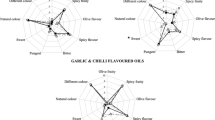Abstract
Plam oils of various qualities were used in this study. Chemical analyses included determination of free fatty acids, peroxide value andp-anisidine value. Sensory evaluations included scoring and descriptive tests. Fresh, crude palm oil of high quality with a maximum score showed a zero peroxide value, a zerop-anisidine value and a free fatty acid level of 0.2%. It had a strong, pleasant, sweet caramel-like flavor. The levels of free fatty acids were higher in samples that had been stored for a long time. Theirp-anisidine values were also higher compared to fresh oils. Flavor intensity of red palm oil did not necessarily indicate quality. Its quality was dependent on the type of flavor, pleasant or otherwise. For refined, bleached and deodorized oil, there was an inverse relationship between flavor intensity and quality with a correlation coefficient of r=−0.87. There was some correlation between overall quality rating by sensory method and quality evaluation by chemical analyses, such as free fatty acids (r=−0.69), peroxide value (r=−0.57) andp-anisidine value (r=−0.49).
Similar content being viewed by others
References
Lawson, H.W.,Standards for Fats and Oils, AVI Publishing Co. Inc., Westport, Connecticut, 1985, pp. 12–19.
Patterson, H.B.W.,Handling and Storage of Oilseeds, Oils, Fats and Meal, Elsevier Applied Science, London, 1989.
Wong, D.W.S.,Mechanism and Theory in Food Chemistry, Van Nostrand Reinhold, New York, 1989, pp. 1–22.
Warner, K., inFlavor Chemistry of Fats and Oils, edited by D.E. Min and T.H. Smouse, American Oil Chemists’ Society, 1985, pp. 207–221.
Gray, J.I.,Ibid., pp. 223–239.
Fioriti, J.A., M.J. Kanuk and R.J. Sims,J. Am. Oil Chem. Soc. 51:219 (1974).
Pohle, W.D., R.L. Gregory and B. Van Giessen, Ibid.:649 (1964).
The Official Methods & Recommended Practices of the American Oil Chemists’ Society, 4th edn., American Oil Chemists’ Society, Champaign, 1987.
Standard Methods for the Analysis of Ois, Fats and Derivatives, 7th edn., International Union of Pure and Applied Chemistry, Blackwell Scientific Publications, London, 1987, pp. 210–211.
Bek-Nielson, B.,Proc. of a Seminar on Market Development of Palm Oil Products, The International Trade Centre UNCTAD/GATT, Geneva, 1978, pp. 86–95.
Nor Aini, I., PORIM Occasional Paper No. 18, Palm Oil Research Institute of Malaysia, 1986, pp. 8–10.
Author information
Authors and Affiliations
About this article
Cite this article
Idris, N.A., Abdullah, A. & Halim, A.H. Evaluation of palm oil quality: Correlating sensory with chemical analyses. J Am Oil Chem Soc 69, 272–275 (1992). https://doi.org/10.1007/BF02635900
Received:
Accepted:
Issue Date:
DOI: https://doi.org/10.1007/BF02635900




